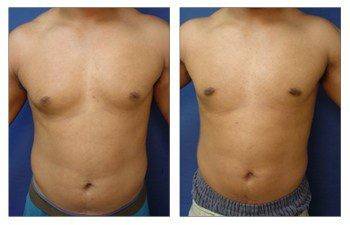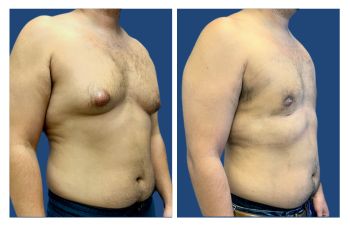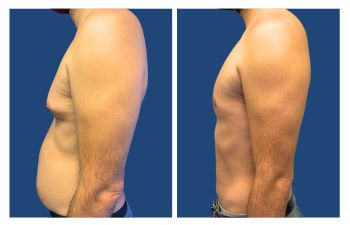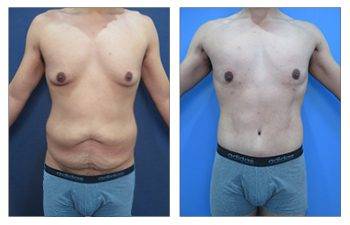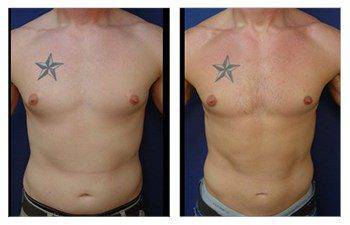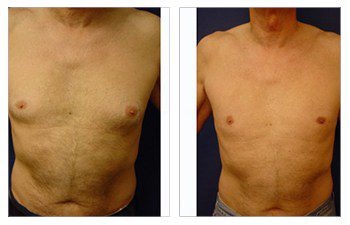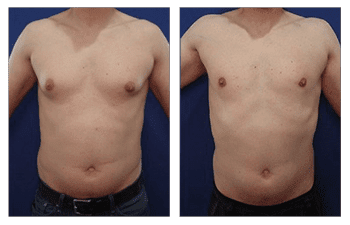Introduction: Puffy Nipples in Men
[ez-toc]
Puffy nipples in men can be caused by various factors, including hormonal imbalances, such as an excess of estrogen or decreased testosterone levels. This can result from factors like puberty, steroid use, obesity, or certain medical conditions. Treatment options for puffy nipples in men include addressing the underlying hormonal imbalances through medication or lifestyle changes, such as exercise and dietary adjustments to reduce body fat and increase muscle mass. Gynecomastia surgery is also an option for severe cases, where excess glandular tissue and fat are removed to create a more contoured chest.
The impact of puffy nipples on men can be distressing, leading to low self-esteem and body image issues. It can affect their confidence and willingness to participate in activities such as swimming or sports. Seeking professional help and support is crucial for those affected by this condition. It is important to consult a healthcare professional to determine the underlying cause and to explore the most suitable treatment options.
Causes of Puffy Nipples in Men
Puffy nipples in men can be caused by several factors, including hormonal imbalances, steroid use, certain exercises, and excess body fat.
Hormonal imbalances, such as an increase in estrogen levels, can lead to the development of puffy nipples. This imbalance can occur during puberty, as well as in older men due to conditions like hypogonadism or obesity. Steroid use can also disrupt hormone levels and lead to the development of puffy nipples.
Certain exercises, particularly those that heavily target the chest muscles, can cause the glandular tissue around the nipples to become enlarged, resulting in a puffy appearance. Additionally, excess body fat can contribute to the appearance of puffy nipples as the fat deposits around the chest area can push the nipple tissue outwards.
These factors can also worsen gynecomastia, a condition characterized by the enlargement of glandular tissue in the male breast. Hormonal imbalances and steroid use can further exacerbate gynecomastia, while exercises and excess body fat can make the condition more prominent. It is important for individuals experiencing puffy nipples or gynecomastia to consult with a healthcare professional for proper evaluation and management.
Puffy Nipples versus Pointed Nipples in Men
Puffy nipples in men are characterized by a protrusion or puffiness of the areola and nipple, often giving a swollen or enlarged appearance. This is often the result of gynecomastia, a condition in which there is an overdevelopment of breast tissue in men, leading to an imbalance of hormones. On the other hand, pointed nipples are typically small and firm, with a more defined shape and less noticeable protrusion.
Gynecomastia can cause puffy nipples due to the hormonal changes that lead to the development of breast tissue. However, targeted exercises focusing on the chest muscles and dietary changes aimed at reducing body fat can help reduce the appearance of puffy nipples. In some cases, surgical options such as male breast reduction surgery may be considered to remove excess tissue and improve the appearance of the chest.
Potential treatment options for puffy nipples include hormone therapy, liposuction, and surgical removal of breast tissue. Male breast reduction surgery, also known as gynecomastia surgery, is a common option for those with persistent puffy nipples. It involves removing excess glandular tissue and fat to achieve a flatter, more masculine chest.
Enlarged or “puffy” areola and nipples in men are often linked to gynecomastia, as the hormonal imbalance can cause both the enlargement of breast tissue and areola. It’s important to consult with a healthcare professional to discuss the best treatment options for addressing puffy nipples and any related concerns.
Puffy Nipples versus Chest Fat in Men
Puffy nipples in men are characterized by the appearance of protruding or swollen nipples, often accompanied by a small glandular tissue underneath. This condition is usually caused by hormonal imbalances during puberty or due to certain medications or medical conditions. On the other hand, chest fat in men refers to an accumulation of excess adipose tissue in the chest area, resulting in a more generalized enlargement of the chest. This can be caused by factors such as obesity, poor diet, and lack of exercise.
Treatment for puffy nipples may include hormone therapy, while chest fat can be addressed through a combination of diet, exercise, and weight loss. In more severe cases, surgical procedures such as liposuction or mastectomy may be considered. Symptoms of puffy nipples and chest fat can include tenderness, swelling, and overall dissatisfaction with one’s appearance. These conditions can have a significant impact on a man’s self-esteem and confidence, leading to feelings of embarrassment and self-consciousness. Overall, it’s essential for individuals experiencing these conditions to consult with a medical professional to discuss the most suitable treatment options.
What Causes Puffy Nipples in men?
Puffy nipples in men can be caused by a variety of factors, ranging from hormonal imbalances to certain medical conditions. Understanding the underlying causes of this condition is important in order to address any potential concerns and seek appropriate treatment if necessary. In this article, we will explore the common reasons behind puffy nipples in men, including hormonal fluctuations, medications, obesity, and gynecomastia. We will delve into each potential cause and explore the symptoms associated with puffy nipples, as well as potential treatment options to alleviate this condition. Understanding the root cause of puffy nipples in men is vital for those experiencing this issue, as it can help guide them toward the most effective solutions to address and manage their symptoms.
1. Genetics
play a significant role in the development of puffy nipples. This condition can be hereditary, meaning that it may be passed down from one or both parents. During puberty, hormonal changes can also contribute to the development of puffy nipples, making them more noticeable.
Genetic predisposition to pronounced nipples involves a combination of gene variants that can influence the shape and size of the nipples. These genetic factors can determine the prominence of the nipples and the timing of when they typically start to become noticeable.
Some individuals may start to notice puffy nipples during puberty, as hormonal changes can cause an increase in glandular tissue in the breast area. This can lead to the development of more prominent nipples, particularly in males.
Addressing this genetic trait may involve considering surgical options for reducing the prominence of puffy nipples, although it’s important to consult with a healthcare professional to discuss the potential risks and benefits. In some cases, puffy nipples may not significantly impact an individual’s overall health or well-being, and they may choose to embrace their genetic traits without seeking intervention.
2. Excess fatty tissue
Excess fatty tissue behind the nipple-areola complex can be caused by hormonal imbalances, being overweight, or simply genetics. Hormonal imbalances, such as during puberty or with certain medical conditions, can lead to the development of excess fatty tissue in the chest area. Being overweight can also contribute to excess fat accumulation in this area.
This excess body fat can lead to breast and nipple swelling, causing discomfort and self-esteem issues for some individuals. The excess fat can also make it difficult to participate in physical activities and can lead to a higher risk of developing health issues related to obesity.
It’s important to differentiate between excess chest fat and gynecomastia, which is the development of breast tissue in males. While both may cause a similar appearance, gynecomastia is caused by hormonal imbalances and usually requires medical intervention to address effectively. Excess chest fat, on the other hand, can be addressed by lifestyle changes such as a healthy diet and regular exercise.
In conclusion, excess fatty tissue behind the nipple-areola complex can be caused by hormonal imbalances and being overweight, leading to breast and nipple swelling. It’s essential to differentiate between excess chest fat and gynecomastia and address each issue effectively with relevant lifestyle changes or medical interventions.
3. Hormonal imbalance
Hormonal imbalances can lead to puffy nipples in both men and women. One potential cause is medication side effects, as certain drugs can disrupt the body’s hormone levels. Hormonal changes during puberty and pregnancy can also contribute to this imbalance, leading to swollen or puffy nipples. Additionally, the effects of estrogen and testosterone on breast tissue growth can play a role. High estrogen levels, in particular, can result in gynecomastia, or breast growth in males. This condition is often caused by an imbalance of hormones, leading to the development of breast tissue. In the long term, gynecomastia can lead to the enlargement of the nipple and breast tissue, which may necessitate medical intervention. Understanding the potential causes of hormonal imbalances that contribute to puffy nipples and gynecomastia is essential for addressing these issues and seeking appropriate treatment.
5. Chafing
Chafing during cardio exercises can be prevented by taking a few simple steps. Firstly, apply a lubricant, such as petroleum jelly or specialized anti-chafing products, to areas prone to chafing, such as inner thighs, underarms, and nipples. For those who experience nipple chafing, wearing nipple guards can provide extra protection. Additionally, opt for moisture-wicking and seamless clothing to reduce friction and moisture buildup, which can exacerbate chafing. If necessary, using band-aids or adhesive tape on sensitive areas can also prevent chafing during workouts.
If chafing does occur, it’s important to address it promptly. Keep the affected area clean and dry, and avoid further irritation by wearing loose-fitting clothing. Applying a healing balm, like aloe vera or calendula, can soothe the skin and promote healing. Most importantly, give the area time to heal before engaging in rigorous exercise again.
By following these chafing prevention methods and techniques for addressing chafed skin, individuals can continue to enjoy their cardio exercises without the discomfort and pain of chafing.
Treatment options for Puffy Nipples in Men
Puffy nipples in men can be a source of self-consciousness and discomfort. Fortunately, there are several treatment options available to address this condition and help individuals feel more confident and at ease with their bodies. From lifestyle changes to surgical interventions, there are a variety of approaches to consider when dealing with puffy nipples. In this article, we will explore the different treatment options for puffy nipples in men, including both non-invasive and surgical procedures, to help individuals make informed decisions about how to address this common concern.
Diet tips
To adjust and modify your diet to reduce excess body fat and lower estrogen levels, start by incorporating more raw fruits and vegetables, high-fiber foods, and testosterone-rich foods. These include foods like broccoli, kale, spinach, berries, apples, and flaxseeds. These foods can help in reducing body fat and regulating estrogen levels in the body.
It’s important to avoid processed foods with added sugars as they can contribute to weight gain and disrupt hormone levels. Similarly, it’s also crucial to steer clear of estrogen-rich foods like soy products, as they can further elevate estrogen levels in the body. Instead, opt for lean proteins, whole grains, and healthy fats to support a balanced hormone profile. Additionally, consuming foods rich in testosterone like eggs, lean cuts of meat, and nuts can help in optimizing hormone levels and supporting a healthy body composition.
By making these dietary modifications, you can effectively work towards reducing body fat and lowering estrogen levels, leading to improved overall health and well-being.
Exercise tips
including chest exercises, back and shoulder exercises, and aerobic activities are crucial in reducing nipple puffiness and breast swelling in men.
Chest exercises help build and strengthen the pectoral muscles, which can reduce the appearance of breast tissue. Back and shoulder exercises can improve overall posture and provide a balanced upper body development, contributing to reducing the appearance of nipple puffiness. Aerobic activities, such as running or swimming, help to reduce overall body fat, including in the chest area.
When performing chest exercises, it’s important to gradually increase the number of sets or weights used to avoid injury. You should listen to your body and not push yourself too hard too quickly.
Incorporating 15-20 minutes of cardio before and after weight lifting workouts, or 45-60 minutes of cardio on days between weight lifting workouts, can further aid in reducing nipple puffiness and breast swelling. This combination of exercises and activities helps to target the chest muscles while also reducing overall body fat, leading to a more sculpted and lean physique.
Surgical Treatment of Puffy Nipples in Men
There are surgical treatment options available for men with puffy nipples, including male breast reduction surgery and nipple reduction surgery. Male breast reduction surgery involves removing excess glandular tissue and fat from the chest to flatten the area and improve the appearance of the nipples. Nipple reduction surgery specifically targets the size and shape of the nipples.
Inflamed, puffy nipples in men can be caused by hormonal imbalances, which may necessitate surgery to correct. Factors such as unsuccessful diet and exercise can also contribute to the development of puffy nipples. In these cases, surgical intervention may be necessary to achieve the desired results.
Male breast reduction surgery and nipple reduction surgery can help address puffy nipples in men by removing excess tissue and fat, resulting in a flatter and more aesthetically pleasing chest. It is important for individuals considering these surgeries to consult with a qualified plastic surgeon to discuss their options and determine the most appropriate treatment plan for their specific needs.
Gynecomastia overview
Gynecomastia is a condition characterized by the enlargement of male breast tissue. The causes of gynecomastia include hormonal imbalances, such as an increase in estrogen levels or a decrease in testosterone levels, which can be attributed to age, genetics, or certain medical conditions. Additionally, the use of certain medications, such as anti-androgens, anabolic steroids, or medications for certain health conditions, can also contribute to the development of gynecomastia.
Symptoms of gynecomastia include swollen breast tissue and tenderness or pain in the breasts. In some cases, there may be a noticeable increase in the size of the areola as well.
Health conditions that are linked to gynecomastia include kidney and liver disease, thyroid disorders, and testicular tumors. It is important for individuals experiencing symptoms of gynecomastia to seek medical attention to rule out any underlying health issues.
Surgical options for treating gynecomastia include male breast reduction surgery, which involves the removal of excess breast tissue through liposuction and/or tissue excision. This procedure can help restore a more masculine chest contour and improve self-confidence for individuals affected by gynecomastia.
Liposuction
Liposuction is a suitable procedure for individuals with excess fat in the breasts and elastic skin, particularly for those with puffy nipples. Vaser Liposuction is an effective technique for targeting and removing excess fat in the chest area, resulting in a more contoured chest with less prominent puffy nipples. The procedure involves using ultrasound technology to break down the fat cells before suctioning them out, allowing for a more precise and gentle approach to fat removal.
For individuals with gynecomastia (enlarged male breasts), a combination of gynecomastia reduction surgery and liposuction can provide even more dramatic results. Gynecomastia reduction surgery addresses the glandular tissue in the breasts, while liposuction targets the excess fat, leading to a more defined and masculine chest appearance.
Overall, liposuction is a suitable and effective option for individuals with excess fat in the breasts, including those with puffy nipples. Vaser Liposuction, in particular, offers a precise and gentle approach to fat removal, while the combination of gynecomastia reduction surgery and liposuction can provide more comprehensive results for a more contoured chest with less prominent puffy nipples.
Surgical excision
Surgical excision for the treatment of gynecomastia involves the removal of excess breast tissue through a surgical procedure. The techniques used in this procedure may include liposuction, mastectomy, non-invasive fat reduction, and tissue excision.
Liposuction is used to remove excess fat from the chest area, while mastectomy involves the removal of glandular tissue through an incision around the areola. Non-invasive fat reduction techniques may use ultrasound or radiofrequency to break down fat cells. Tissue excision involves the surgical removal of excess glandular tissue.
The recovery time for surgical excision of gynecomastia can vary depending on the specific technique used. In general, patients can expect to resume normal activities within a few days to a week. Strenuous activities and exercise should be avoided for a few weeks to allow for proper healing.
It is important to note that individual recovery times may vary, and it is crucial to follow post-operative care instructions provided by the surgeon. In summary, surgical excision for gynecomastia treatment offers various techniques and recovery times, providing an effective solution to this condition.
Renuvion Skin Tightening
Renuvion skin tightening is a non-invasive cosmetic treatment that uses a combination of helium plasma and radiofrequency energy to tighten and rejuvenate the skin. The procedure works by heating the deeper layers of the skin, stimulating collagen production, which leads to firmer and more youthful-looking skin.
By combining the unique properties of helium plasma and radiofrequency energy, Renuvion skin tightening effectively tightens and lifts the skin without the need for invasive surgery. The helium plasma delivers controlled thermal energy to the targeted area, while the radiofrequency energy helps to further tighten and improve the skin’s texture. This dual-action treatment not only tightens the skin but also stimulates the production of collagen, the protein responsible for skin firmness and elasticity.
Renuvion skin tightening offers numerous benefits, including minimal downtime, long-lasting results, and the ability to treat multiple areas of the body. This innovative treatment is a popular option for individuals looking to achieve a more youthful appearance without undergoing surgery.
Conclusion: Puffy Nipples in Men
Puffy nipples in men can be caused by various factors, including hormonal imbalances, certain exercises and chafing, and excess body fat. Hormonal imbalances, such as an increase in estrogen levels, can lead to the development of puffy nipples. Certain exercises, like bench presses or other chest-focused workouts, can also result in puffy nipples due to the overdevelopment of the pectoral muscles. Furthermore, chafing and excess body fat can contribute to the appearance of puffy nipples in men.
Remedies for puffy nipples may include making dietary and exercise-related changes. Reducing body fat through a healthy diet and regular exercise can help alleviate the appearance of puffy nipples. In some cases, when puffy nipples persist despite efforts to address the underlying causes, surgical intervention may be considered.
Additionally, factors associated with Gynecomastia, a condition characterized by enlarged or “puffy” areola and nipples in men, can also lead to the development of puffy nipples. Gynecomastia may be caused by hormonal imbalances, certain medications, or underlying health conditions.
In conclusion, puffy nipples in men can be caused by hormonal imbalances, certain exercises and chafing, and excess body fat. Remedies may include dietary and exercise-related changes, or surgical intervention if necessary. Factors associated with Gynecomastia can also contribute to the development of puffy nipples in men.










